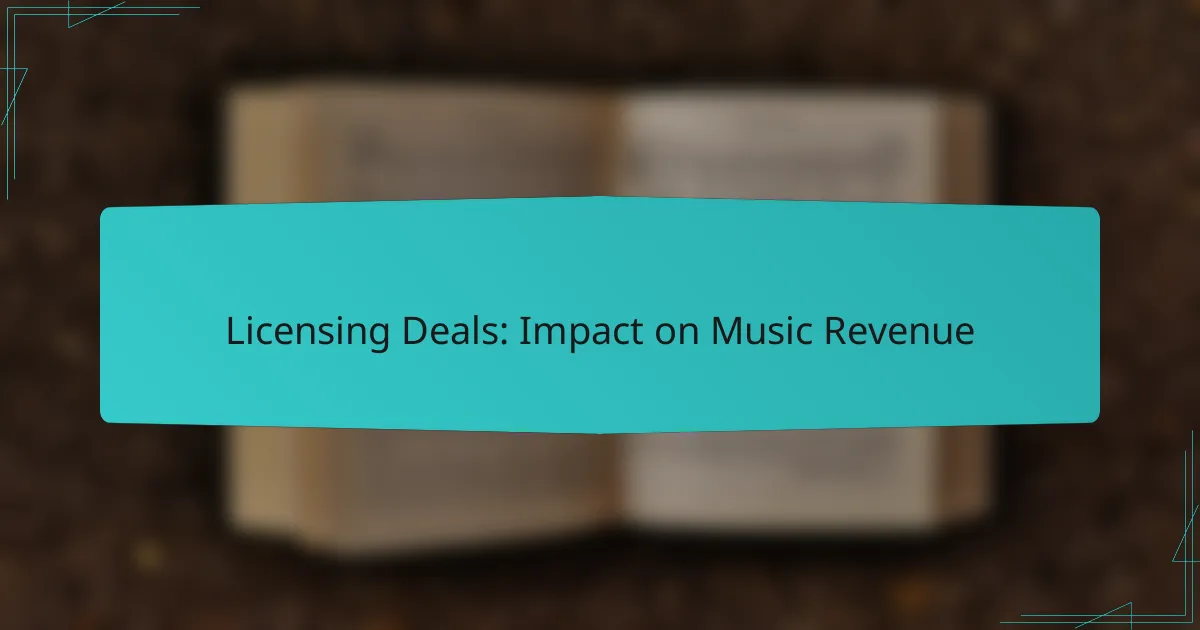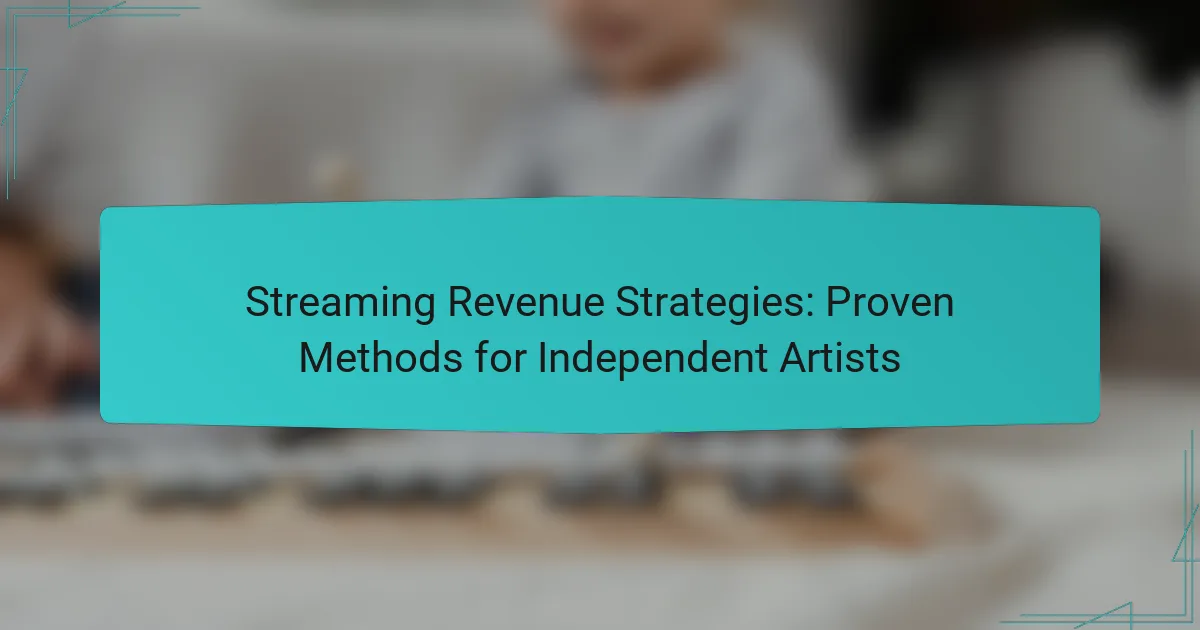Licensing deals play a crucial role in shaping music revenue in the US by providing new income avenues for artists and rights holders. By permitting the use of music across various media, these agreements generate additional royalties that can significantly boost overall earnings. Different types of licenses, such as synchronization, mechanical, and public performance licenses, each contribute to distinct revenue streams, while digital platforms influence the terms of these deals, further affecting artists’ financial outcomes.
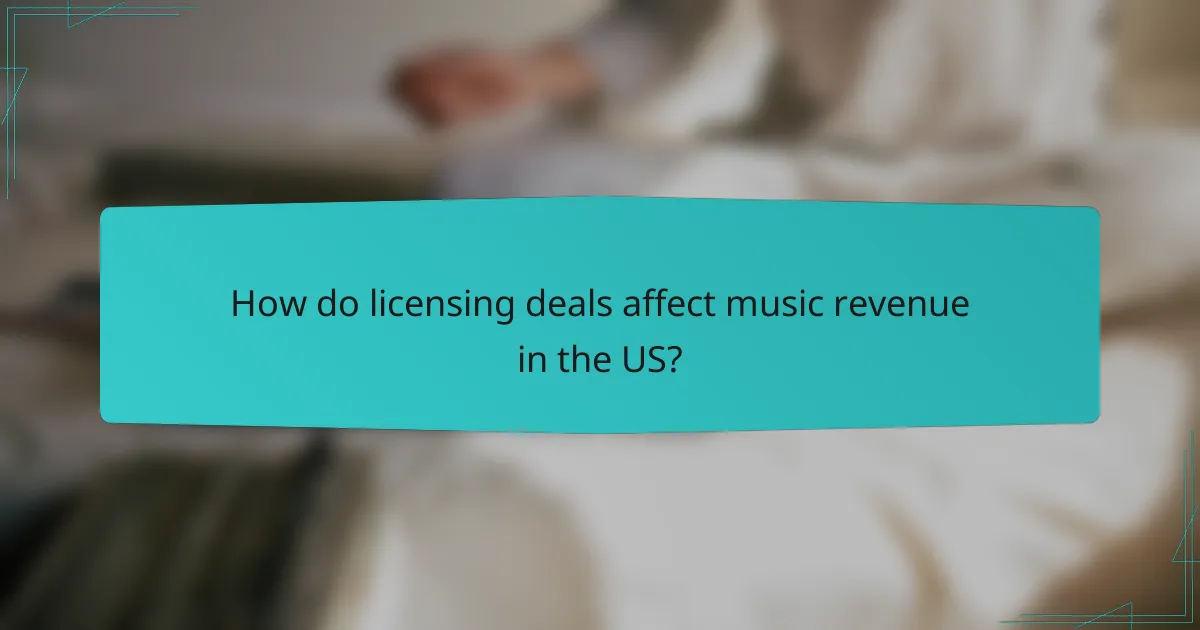
How do licensing deals affect music revenue in the US?
Licensing deals significantly impact music revenue in the US by creating new income opportunities for artists and rights holders. These agreements allow for the use of music in various media, generating additional royalties that can enhance overall earnings.
Increased revenue streams
Licensing deals open up multiple revenue streams for musicians, including synchronization licenses for film, television, and advertising. By allowing their music to be featured in these platforms, artists can earn substantial fees, often ranging from hundreds to thousands of dollars per placement.
Additionally, digital platforms and streaming services have begun to incorporate licensing agreements that further monetize music. This can include partnerships with brands or exclusive content deals, which can lead to increased visibility and revenue for artists.
Impact on artist earnings
The earnings from licensing deals can vary widely based on the popularity of the artist and the specific usage of their music. Established artists may command higher fees, while emerging musicians might receive lower compensation but gain valuable exposure.
Moreover, licensing can provide a more stable income compared to traditional sales, as it often results in upfront payments and ongoing royalties. This shift allows artists to diversify their income and reduce reliance on album sales alone, which have been declining in recent years.
Changes in distribution models
Licensing deals have prompted shifts in how music is distributed and consumed. Artists are increasingly leveraging digital platforms to reach audiences directly, often bypassing traditional record labels. This allows for more control over their music and potential earnings.
Furthermore, the rise of streaming services has led to new licensing models that prioritize accessibility and exposure. Artists can now negotiate terms that align with their brand and audience, ensuring they benefit from the growing digital landscape.
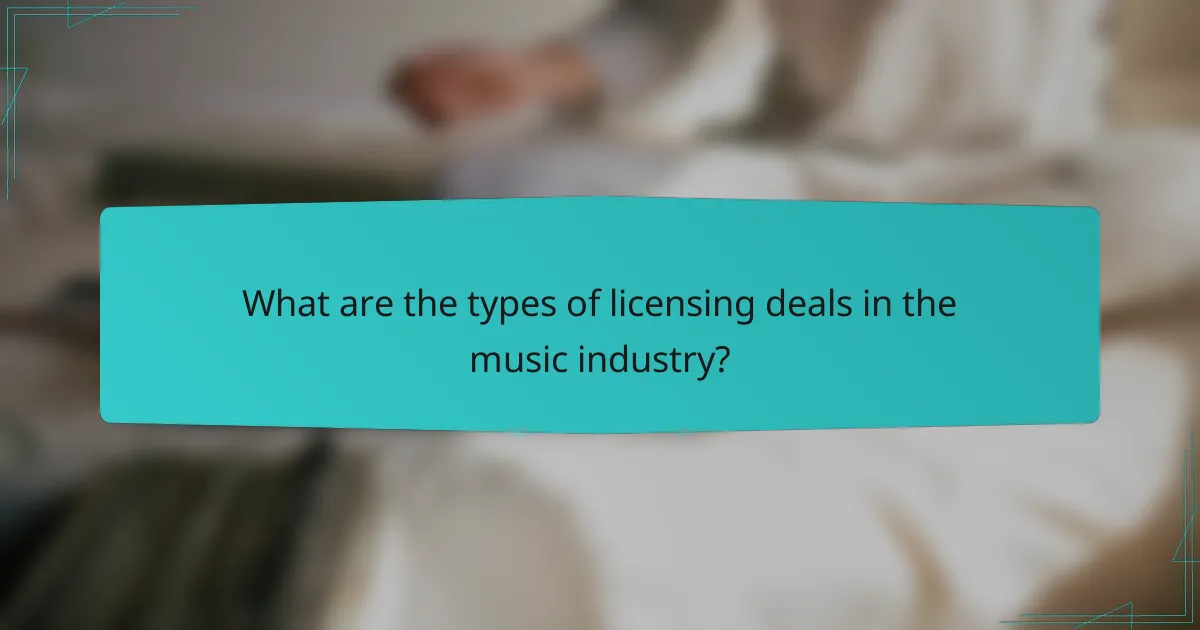
What are the types of licensing deals in the music industry?
Licensing deals in the music industry primarily involve agreements that allow the use of music in various contexts, generating revenue for artists and rights holders. The main types include synchronization licenses, mechanical licenses, and public performance licenses, each serving distinct purposes and revenue streams.
Synchronization licenses
Synchronization licenses permit the use of music in audiovisual works, such as films, TV shows, commercials, and video games. This type of license is crucial for creators who want to enhance their projects with music, and it typically requires negotiation between the rights holder and the producer.
Fees for synchronization licenses can vary widely, often ranging from hundreds to thousands of dollars, depending on the popularity of the song and the scope of its use. It’s essential for artists to understand the terms of these agreements, as they can significantly impact overall revenue and exposure.
Mechanical licenses
Mechanical licenses are required for the reproduction of music in physical formats, such as CDs and vinyl, as well as digital downloads. These licenses ensure that songwriters and publishers receive royalties when their music is reproduced and distributed.
In the United States, mechanical royalties are typically calculated at a statutory rate, which is set by law and can change periodically. Artists should be aware of the licensing requirements in their respective countries, as regulations may differ, affecting potential earnings from physical and digital sales.
Public performance licenses
Public performance licenses allow music to be played in public spaces, such as restaurants, bars, and concert venues. These licenses are usually obtained through performance rights organizations (PROs), which collect fees on behalf of artists and distribute royalties accordingly.
Fees for public performance licenses can vary based on factors like venue size and music usage frequency. It’s important for venue owners and performers to secure these licenses to avoid legal issues and ensure that artists are compensated for their work.
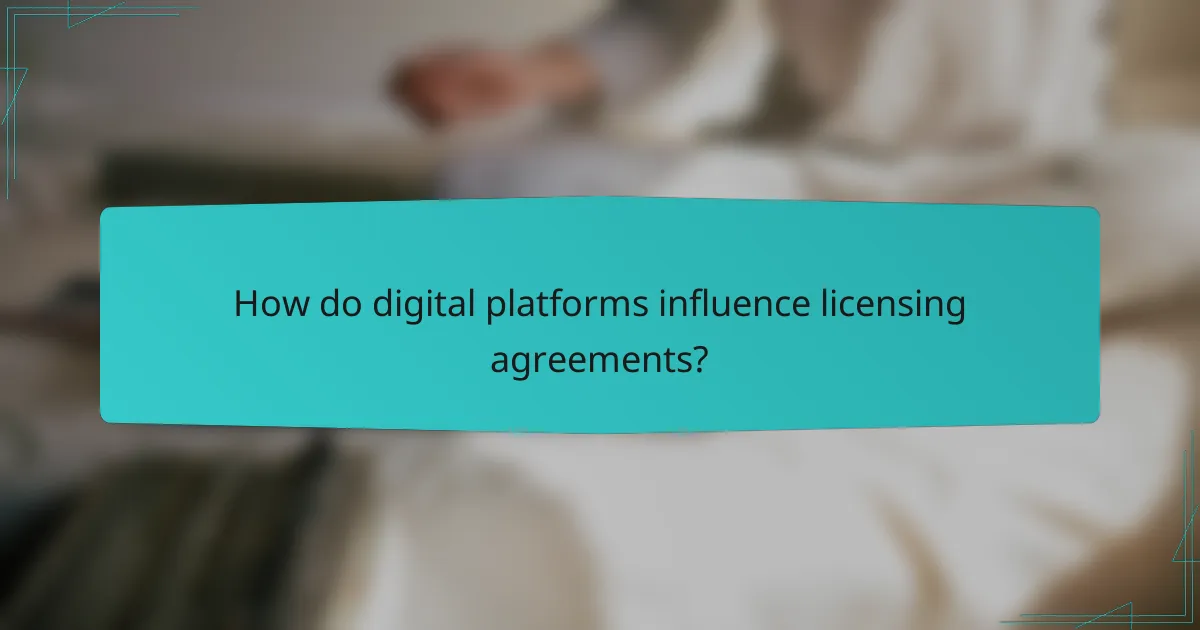
How do digital platforms influence licensing agreements?
Digital platforms significantly shape licensing agreements by dictating the terms under which music is distributed and monetized. These platforms often leverage their vast user bases to negotiate favorable deals that can impact revenue streams for artists and labels.
Streaming service royalties
Streaming services like Spotify and Apple Music typically pay artists through a royalty system based on the number of streams. Royalties can vary widely, often ranging from a fraction of a cent to a few cents per stream, depending on the service and the artist’s contract. This model emphasizes the importance of having a strong presence on these platforms to maximize earnings.
Artists should consider negotiating terms that ensure fair compensation, such as higher royalty rates or upfront payments. Understanding the specific payout structures of each platform can help artists make informed decisions about where to focus their efforts.
Impact of YouTube monetization
YouTube monetization offers a different revenue model, primarily through ad revenue generated from views. Artists can earn money based on the number of ads shown during their videos, with earnings typically ranging from a few dollars to several hundred dollars per thousand views. This creates an incentive for artists to produce engaging content that attracts viewers.
To maximize earnings on YouTube, artists should focus on optimizing their video content for search and engagement. Utilizing effective titles, descriptions, and tags can significantly increase visibility and, consequently, revenue. Additionally, artists should be aware of copyright regulations to avoid potential demonetization of their content.
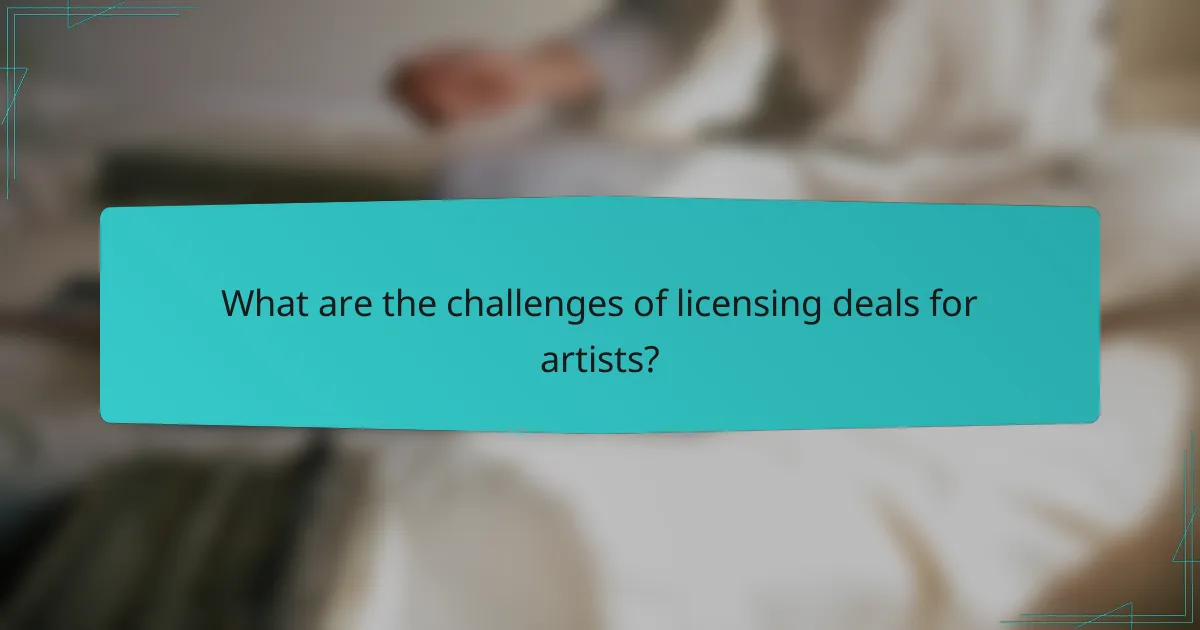
What are the challenges of licensing deals for artists?
Licensing deals present several challenges for artists, primarily due to the complexity of negotiations and potential disputes over revenue sharing. These issues can significantly affect an artist’s income and their relationship with labels and other stakeholders.
Complexity of negotiations
Negotiating licensing deals can be intricate, involving multiple parties such as record labels, publishers, and distributors. Each party has its own interests, which can lead to lengthy discussions and potential misunderstandings.
Artists must be well-informed about their rights and the terms being proposed. Seeking legal advice or representation can help navigate these complexities and ensure that the artist’s interests are adequately protected.
Revenue sharing disputes
Revenue sharing disputes often arise when the terms of a licensing deal are unclear or not mutually agreed upon. Artists may find themselves receiving a smaller percentage of revenue than anticipated, leading to frustration and financial strain.
To avoid such disputes, artists should clearly outline revenue-sharing terms in the contract, specifying percentages and payment timelines. Regular communication with all parties involved can also help prevent misunderstandings and ensure a smoother revenue distribution process.

How can artists maximize revenue from licensing deals?
Artists can maximize revenue from licensing deals by strategically promoting their music and collaborating with brands that align with their image. Understanding the nuances of licensing agreements and leveraging various platforms can significantly enhance earnings.
Leveraging social media
Social media platforms are powerful tools for artists to showcase their work and attract licensing opportunities. By regularly sharing content, engaging with fans, and utilizing targeted ads, artists can increase their visibility and appeal to potential licensors.
Platforms like Instagram, TikTok, and YouTube allow artists to demonstrate how their music can fit into different contexts, such as commercials or films. Posting snippets of their tracks alongside visuals can help potential partners envision the music in their projects.
Collaborating with brands
Collaborating with brands can create lucrative licensing opportunities for artists. By aligning with brands that share similar values or target audiences, artists can enhance their marketability and open doors to exclusive deals.
For instance, a clothing brand might seek a specific sound for their advertising campaign. Artists can negotiate terms that not only provide upfront payments but also include royalties based on sales or usage. This dual approach can lead to increased revenue over time.
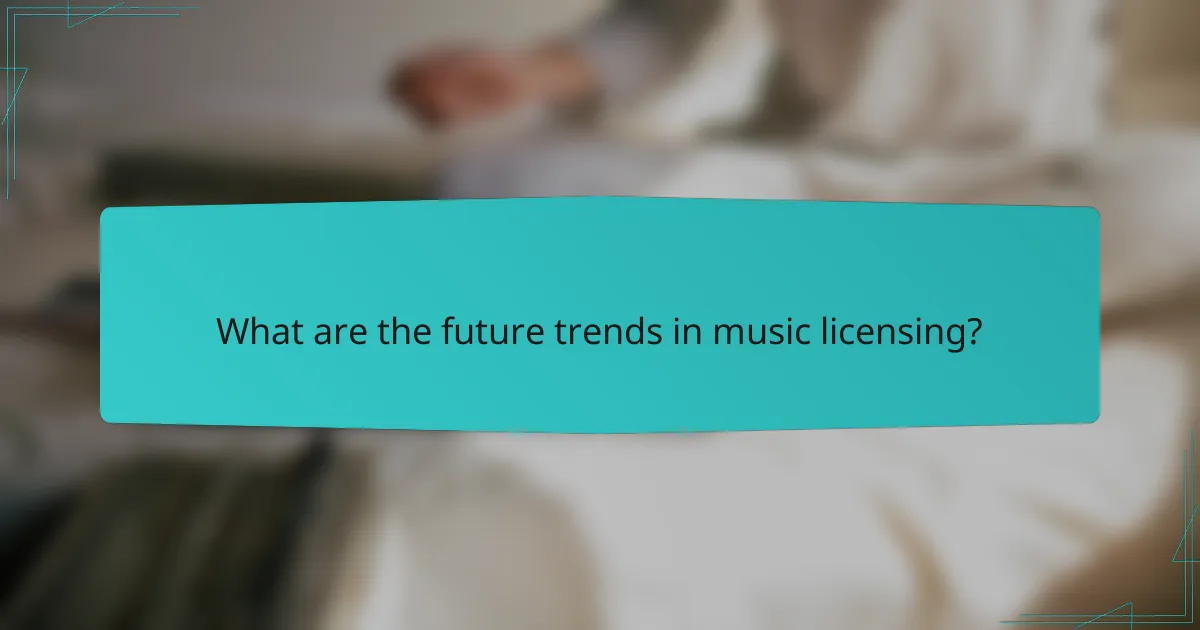
What are the future trends in music licensing?
Future trends in music licensing are increasingly shaped by technological advancements and changing market dynamics. Key areas to watch include the rise of NFTs, the influence of artificial intelligence, and the expansion into emerging markets.
Growth of NFT music licensing
NFT music licensing is gaining traction as artists seek new revenue streams and ways to engage fans. By creating unique digital assets tied to their music, artists can sell ownership rights directly to consumers, often at premium prices.
This trend allows for greater control over distribution and monetization. Artists can set terms for resale and earn royalties on future sales, creating a sustainable income model. However, the volatility of the NFT market and the need for technical knowledge can pose challenges.
Impact of AI on music rights
Artificial intelligence is transforming music rights management by automating processes such as copyright detection and royalty distribution. AI tools can analyze vast amounts of data to identify potential infringements and ensure that creators are compensated fairly.
While AI enhances efficiency, it also raises questions about ownership and the originality of AI-generated music. Artists and rights holders must navigate these complexities to protect their interests in a rapidly evolving landscape.
Emerging markets for licensing
Emerging markets, particularly in Asia and Africa, present significant opportunities for music licensing growth. As internet access expands and mobile streaming becomes more prevalent, local artists can tap into new audiences and revenue sources.
Licensing deals in these regions often require tailored approaches that consider cultural nuances and local regulations. Collaborations with local entities can facilitate market entry and enhance the effectiveness of licensing strategies.
